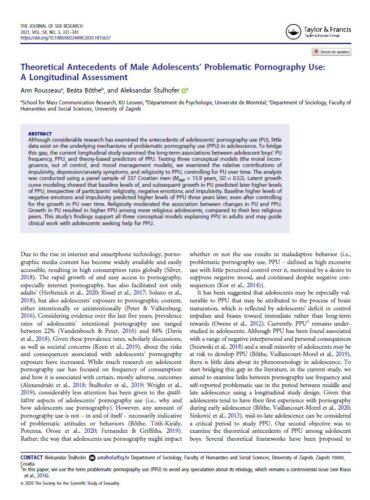Mental Health
Theoretical Antecedents of Male Adolescents’ Problematic Pornography Use: A Longitudinal Assessment
Open Access: N0.
Abstract
Although considerable research has examined the antecedents of adolescents’ pornography use (PU), little data exist on the underlying mechanisms of problematic pornography use (PPU) in adolescence. To bridge this gap, the current longitudinal study examined the long-term associations between adolescent boys’ PU frequency, PPU, and theory-based predictors of PPU. Testing three conceptual models (the moral incongruence, out of control, and mood management models), we examined the relative contributions of impulsivity, depression/anxiety symptoms, and religiosity to PPU, controlling for PU over time. The analysis was conducted using a panel sample of 337 Croatian men (Mage = 15.9 years, SD = 0.52). Latent growth curve modeling showed that baseline levels of, and subsequent growth in PU predicted later higher levels of PPU, irrespective of participants’ religiosity, negative emotions, and impulsivity. Baseline higher levels of negative emotions and impulsivity predicted higher levels of PPU three years later, even after controlling for the growth in PU over time. Religiosity moderated the association between changes in PU and PPU. Growth in PU resulted in higher PPU among more religious adolescents, compared to their less religious peers. This study’s findings support all three conceptual models explaining PPU in adults and may guide clinical work with adolescents seeking help for PPU.
Relevance
Impulsiveness (delaying gratification) “predicted” increased problematic pornography use among adolescents. These adolescents also had “higher deficits in response inhibition” in that they continued to use pornography despite its negative consequences.
Depression and anxiety also “predicted” increased problematic pornography use among adolescents. This is due to the inability to self-regulate and also turning to pornography for mood management (i.e., distraction from negative emotions).
Adolescents with more religious faith also had higher levels of problematic pornography use – or self-perceived pornography use due to acute moral incongruence.
Citation
Rousseau, A., Bőthe, B., & Štulhofer, A. (2021). Theoretical Antecedents of Male Adolescents’ Problematic Pornography Use: A Longitudinal Assessment. Journal of sex research, 58(3), 331–341. https://doi.org/10.1080/00224499.2020.1815637

